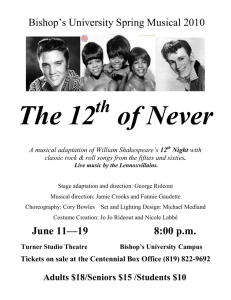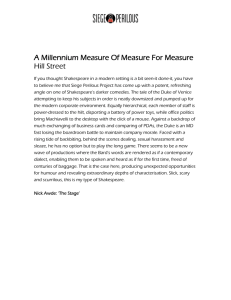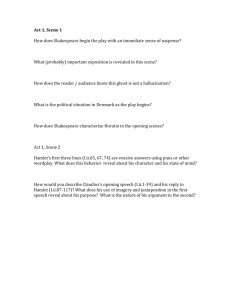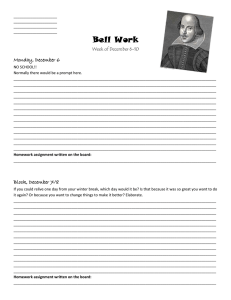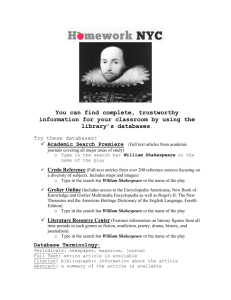File
advertisement
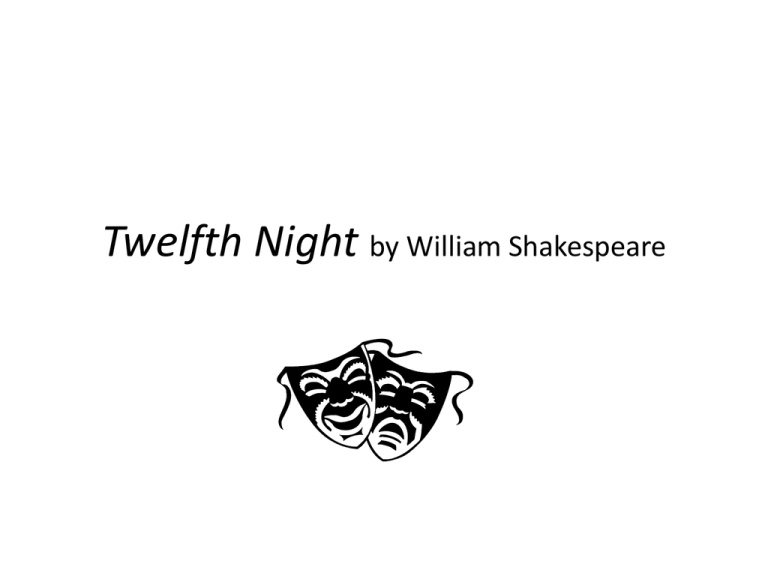
Twelfth Night by William Shakespeare Comedy • Definition – a comedic play has at least one humorous character, and a successful or happy ending. • Characteristics of … – The main action is about love. – The would-be lovers must overcome obstacles and misunderstandings before being united in harmonious union. The ending frequently involves a parade of couples to the altar and a festive mood or actual celebration (expressed in dance, song, feast, etc.) Twelfth Night has three such couples. – Frequently (but not always), it contains elements of the improbable, the fantastic, the supernatural, or the miraculous, e.g. unbelievable coincidences, improbable scenes of recognition/lack of recognition, willful disregard of the social order (nobles marrying commoners, beggars changed to lords), instantaneous conversions (the wicked repent), enchanted or idealized settings, supernatural beings (witches, fairies, Gods and Goddesses). The happy ending may be brought about through supernatural or divine intervention (comparable to the deus ex machina in classical comedy, where a God appears to resolve the conflict) or may merely involve improbable turns of events. – In the best of the mature comedies, there is frequently a philosophical aspect involving weightier issues and themes: personal identity; the importance of love in human existence; the power of language to help or hinder communication; the transforming power of poetry and art; the disjunction between appearance and reality; the power of dreams and illusions). Twelfth Night: What does the title refer to? • The play was written as a Christmas season production for presentation on Epiphany – the twelfth night after Christmas, when, according to religious tradition, Jesus was introduced to the world. • It is a time for celebrating, gifts are exchanged, and parties and other celebrations occur. • The full title of the play is Twelfth Night, or, What You Will – i.e. “Call it anything you choose.” Twelfth Night • • • • • Type of work: play (Shakespeare also wrote: poetry) Genre: comedy Time written: between 1600-1602 Place written: England Tone: Light, cheerful, comic; occasionally frantic and melodramatic, especially in the speeches of Orsino and Olivia. • Tense: Present (the entire story is told through dialogue) • Setting (time): Unknown • Setting (place): The mythical land of Illyria (Illyria is a real place, corresponding to the coast of present-day Yugoslavia, but Twelfth Night is clearly set in a fictional kingdom rather than a real one.) Twelfth Night Characters: • • • • • • Viola (a.k.a. Cesario) Duke Orsino Olivia Sebastian Malvolio Feste • • • • Sir Toby Belch Maria Sir Andrew Aguecheek Antonio Other characters… • Fabian – servant to Olivia; friend to Maria, Sir Toby, and Andrew. Assists in the practical joke on Malvolio. • Valentine – gentleman attending to the Duke • Curio – gentleman attending to the Duke • Priest - (named Sir Topas); he marries Olivia to “Cesario;” he is impersonated by Feste. • Captain (sea captain) – assists Viola (helps disguise Viola as Cesario) A Closer Look at the play… • Plot Summary: In Twelfth Night, as in most of his works, Shakespeare has several different plot-lines going on at the same time. He expertly weaves these separate stories together throughout the play. As the play begins to move towards its conclusion the different stories begin to converge until they all come together for a resolution in the final scenes. Dramatic Structure • Major Conflict (__________): Viola is in love with Orsino, who Problem is in love with Olivia, who is in love with Viola’s male disguise, love triangle is complicated by the fact that Cesario. This __________ neither Orsino nor Olivia knows that Cesario is really a woman __________ (Viola). Rising Action confusion • _____________: The mounting __________, ___________________, and _______________, mistaken identities professions of love leading up to Act V. Climax Sebastian and ________ Viola are ________, reunited and • __________: __________ everyone realizes that Cesario is a woman. Falling Action Viola _______________ prepares to marry Orsino; Malvolio is • ___________: vows revenge freed and _______________. • __________________: Denouement/Resolution Everyone goes off to celebrate. Themes suffering Love • __________ as a cause of _________ • The uncertainty of gender folly ambition • The _____ of __________ Act and Scene Summaries (As you read, summarize each scene – identify the who and the what; then summarize each act) Act 1 Act 2 Act 3 Act 4 Act 5 Scene 1 Scene 1 Scene 1 Scene 1 Scene 1 Scene 2 Scene 2 Scene 2 Scene 2 X Scene 3 Scene 3 Scene 3 Scene 3 X Scene 4 Scene 4 Scene 4 X X Scene 5 Scene 5 X X X Themes: Reflection Questions As you read the play, explore the themes of 1) Vanity or "Self Love“; 2) Masks and Disguises (appearance vs. reality); 3) Fools and Ambition (the folly of ambition); 4) Gender Confusion (mistaken identities); 5) Love and Suffering (love as a cause for suffering) … 1) Vanity or "Self Love" – Who demonstrates vanity? How does it end up hurting them? Do they overcome it? How does each character's "self love" manifest itself? 2) Masks and Disguises – Who disguises themselves and why? What disguises are literal and what are they meant to protect the person from? What other kind of masks do characters wear? When do they come off and why? 3) Fools and Ambition – There are many kinds of Fools in Twelfth Night. What is the difference between each kind? How does each characters' ambition make them act like a fool? Who is made a fool in the play? What does this say about the characters? 4) Gender Confusion – In Shakespeare's time, women were not allowed to perform on stage. So, all of the roles were performed by boys. This means that Olivia was played by a young boy. Viola was a boy, pretending to be a girl, pretending to be a boy! Imagine what a job that must have been! How does Shakespeare make this clear to us as an audience? How does he use it to humorous effect? 5) Love and Suffering – How closely related are the ideas of love and suffering? Does anyone fall in love in this play who doesn't suffer? How does this relate to your own life? Do some of the characters even enjoy their own suffering? As you read the play, explore the Common Motifs (Patterns in Shakespeare’s plays) 1. 2. 3. 4. 5. 6. 7. 8. 9. Contrasting worlds Rise of one person at the expense of another Disguise and deceptions The supernatural Redemption / reconciliation Disorder yields to order Comic relief scene Parallel characters / foils Eavesdropping • • Explore how each device occurs in the play? What significance does it have in the overall plot or to the overall theme? Apply the Patterns to Twelfth Night Motifs found in many of Shakespeare’s plays Examples (use these or discover your own) 1. Contrasting worlds Appearance vs. Reality; Male vs. female 2. Rise of one person at the expense of another Maria vs. Malvolio 3. Disguise and deceptions Viola = Cesario 4. The Supernatural Idea of fate; a ghost? 5. Redemption/Reconciliation Marriages 6. Disorder yields to order Mistaken identities and the revelation of the characters 7. Comic relief scene Feste’s verbal jabs with characters like Olivia and Cesario; Malvolio’s letter 8. Parallel characters (or foils) Duke Orsino and Olivia; Maria and Malvolio 9. Eavesdropping Sir Toby and Sir Andrew Explanations (Further elaborate on the examples) Shakespeare’s Language • The language Shakespeare used is an early form of Modern English that is different from today’s English in a variety of ways. The following list, with examples from Twelfth Night, describes some characteristics of Shakespeare’s English. Whereas some of the following practices were observed in everyday speech, others were poetic conventions. Shakespeare often used contractions or omitted syllables in order to maintain the meter. Shakespeare’s Language cont’d. 1. Shakespeare frequently made contractions of words that we write separately today. He also dropped letters, particularly vowels, at the ends of words and in the ending –est. Orsino: ’Tis [it is] not so sweet now as it was before. (1.1.8) Toby: She’ll none o’ [of] th’ [the] Count. (1.3.104) Toby: O knight, thou lack’st [lackest] a cup of canary! (1.3.79) Andrew: And you love me, let’s do’t [do it]. I am dog at a catch. (2.3.61) * Remember: if you see the apostrophe ( ’ ), then something has been omitted. Shakespeare’s Language cont’d. 2. Shakespeare omitted entire unstressed syllables or consonants from the beginning or middle of words. Viola: Whoe’er [whoever] I woo, myself would be his wife. (1.4.42) Malvolio: Were not ev’n [even] now with the Countess Olivia? (2.2.1) Shakespeare’s Language cont’d. 3. Shakespeare used many words (such as the adverbs hence, thence, whence, hither, thither, and whither and the pronouns thy, thou, thee, and thine) that we no longer or rarely use today. Words that have dropped out of the language are called archaic. Olivia: Whence [from what place] came you, sir? (1.5.175) Duke: Then let thy [your] love be younger than thyself [yourself], ( 2.4.36) [hence – from now; thence – from that time or place; whence – from what place?; hither – to this place, nearer, from here; thither – there; whither – from where?] [thy –your; thou – you; thee – you; thine – yours; prithee – please; Ay – yes; ho – look there] Shakespeare’s Language cont’d. 4. Archaic words include forms of verbs with endings such as –th and –st, as well as irregular verb forms such as spake (spoke). Olivia: Why, how dost [do] thou, man? What is the matter with thee? (3.4.24-25) Shakespeare’s Language cont’d. 5. Shakespeare freely used words as different parts of speech, sometimes inventing words in the process. The following slides are words and phrases credited to Shakespeare… Words of note-• The human condition can be difficult to capture through words, especially when the English language is limited. In Shakespeare’s time, there simply wasn't a single word for "lonely" or "generous." So Shakespeare did what any person in search of the right word does in times of crisis: He made them up. He is credited for making up over 3,000 words. Here are some words that Shakespeare is credited with inventing: accused addiction advertising aerial alligator amazement arouse articulate assassination bandit beached bedroom befriend besmirch birthplace blanket blushing bloodstained bump buzzer caked cater champion circumstantial cold-blooded compromise countless courtship critic critical duanting dawn deafening demure discontent dishearten dislocate dwindle educate elbow entomb epileptic equivocal excitement exposure eyeball fashionable fixture flawed frugal generous gloomy gnarled gossip gust hint hobnob hoodwink hurried hurry impartial impede investment invulnerable jaded label lackluster lapse laughable leapfrog lonely lower luggage majestic marketable metamorphize mimic misplaced monumenta moonbeam mountaineer negotiate noiseless numb obscene obsequious ode olympian outbreak pander pedant premeditated radiance rant remorseless savagery scuffle secure submerge summit swagger torture tranquil trickling undress unreal varied vaulting wappened worthless zany And Phrases, too • Shakespeare also spent many of his hours trying to come up with that almost agonizingly appropriate phrase for some of his thoughts. After all, what are words but minds at play? Below is a long laundry list of the common phrases Shakespeare is credited with inventing (yes, he invented every phrase he wrote, but these are the ones that have lasted into current slang/prose/language): • • • • • • • • • • • • • • • • • all corners of the world All that glitters is not gold as ____ as the day is long as luck would have it band of brothers blinking idiot budge an inch (or not) catch cold charmed life dead as a doornail devil incarnate didn't sleep a wink eat me out of house and home fair play fancy free flaming youth fool's paradise • • • • • • • • • • • • • • • • forever and a day for goodness' sake foul play give the devil his due good riddance green-eyed jealousy high time hoist by your own petard household word in a pickle in stitches in the twinkle of an eye into thin air It's Greek to me laughing stock love is blind • • • • • • • • • • • • • • • make haste method to one's madness neither here nor there no rhyme or reason off with his head! Oh woe is me one fell swoop play fast and loose primrose path rotten to the core seen better days send one packing short shrift sink or swim Some are born great, some achieve greatness, and some have greatness thrust upon them • • • • • • • • • • • • • • • • • sorry sight sweets to the sweet the game is afoot the game is up the long and short of it there's the rub tongue tied too much of a good thing tower of strength Tut, tut! under the weather Uneasy lies the head that wears the crown What a piece of work is man What is past is prologue what the dickens wild goose chase your own flesh and blood Shakespeare’s Language cont’d. 6. Shakespeare also inverted his sentences (that is, he rearranged the parts of a sentence). Presently, the normal sentence structure is Subject + Predicate [Subject + verb + complements]. Shakespeare rearranged the parts of the sentence (i.e. by placing the complements before the subject or verb) in order to meet the meter or to emphasize one word or part of the sentence over another [also it was common practice in his day]. For example: Olivia (Shakespeare): Under your hard construction must I sit, / To force that on you in a shameful cunning / Which you knew none of yours. – 3.1.117-119 Olivia (Rearranged): “I must sit under your hard construction [harsh interpretation] to force that on you in a shameful cunning which you knew none of yours.” [Modern translation: You probably think poorly of me after I forced that [ring] on you with such outrageous trickery.] Let’s practice translating Shakespeare’s Language to today’s English… Rewrite these lines from Othello in today’s English, replacing the italicized, archaic words and spellings with more modern forms. 1. Andrew: By my troth, the fool has an excellent breast. ... ’Twas very good i’ faith. I sent thee sixpence for thy leman. Hadst it? (2.3.19-26) By my truth (I swear), the fool as an excellent breast…It was very good in faith. I sent you sixpence for your leman. Did you have/get it? 2. Toby: Th’ art i’ th’ right. (2.3.118) You are in the right. 3. Olivia: I prithee tell me what thou think’st of me. (3.1.140) Please tell me what you think of me, 4. Clown: Nay, I’ll ne’er believe a madman till I see his brains. (4.2.119-120) No, I will never believe a madman until I see his brains. 5. Sebastian: Fear’st thou that, Antonio? (5.1.222) Do you fear that, Antonio? Tools for The Text: Paraphrase • • • • Reading a Shakespeare play can be a daunting task. Shakespeare's language can make it difficult to lose yourself within its pages. However, there are a few tools you can use to help break down the text into something more understandable and enjoyable. The first tool is called Paraphrasing. This is when you take the text and put it into your own words. This is not only a useful tool for reading the language, but it is the primary method of deconstructing the text by the Shakespeare Festival's artists. Although the words used 400 years ago are similar, their meaning was quite different. Examine the following lines from the very beginning of Twelfth Night, when Duke Orsino demands more music, hoping it will cure his lovesickness. If music be the food of love, play on, Give me excess of it, that, surfeiting, The appetite may sicken, and so die. That strain again. It had a dying fall; O, it came o'er my ear like the sweet sound That breathes upon a bank of violets, Stealing and giving odor. Enough, no more. 'Tis not so sweet now as it was before. One possible paraphrase might read: – If it's true that music is the food of love, keep playing. Give me too much so I'll be stuffed and I won't want it any more. Play that bit again! It definitely had the right sound to make my appetite die. It sounded as sweet as a breeze that blows across a patch of violets. Taking their scent and giving it to me. Stop, that's enough. It's not as sweet as it was before. Tools for the Text: Imagery • • • • • Another great tool to further and deepen your understanding of Shakespeare is imagery. These are the pictures that Shakespeare paints with specific words. Just as pictures go through your mind when you read a book, Shakespeare used even more profound words to create very powerful images. Let's look at Duke Orsino's monologue again: If music be the food of love, play on, Give me excess of it, that, surfeiting, The appetite may sicken, and so die. That strain again. It had a dying fall; O, it came o'er my ear like the sweet sound That breathes upon a bank of violets, Take a look at the words in bold. Step one is to write down the first few images that come into your mind: – Food:___________________________________________________________ – Love:___________________________________________________________ – Excess:_________________________________________________________ – Sicken:_________________________________________________________ – Dying:_________________________________________________________ – Sweet:_________________________________________________________ – Breathes:_______________________________________________________ – Violets:_________________________________________________________ Now ask yourself what those images mean to you. How do they make you feel? What kind of actions do they make you want to do? What words effect you most? Now that you've found some personal connection to these words, say the monologue out loud and allow those images to fill your mind. Allow them to effect you and your audience as you speak. Tools for the Text: Iambic Pentameter • Take a look at the monologue we used in the previous two examples. Did you notice a rhythm to the lines when you said them? Did you notice that the first letter of every line is capitalized? This is because Shakespeare chose to write much of his text in Iambic Pentameter. You'll find many explanations for what this means, but one simple way is to say that each line has 10 syllables - 5 stressed and 5 unstressed. Here is an example: – If music be the food of love, play on, • Count the syllables. You can see that it has 10 syllables. Now we will break the line up into smaller sections that have two syllables. These sections are called feet: – If mu • sic be the food of love, play on, Watch out when breaking a line into feet. You'll notice that sometimes a word can be broken up (like mu-sic). Now, within each foot there is usually one stressed and one unstressed syllable. In Iambic Pentameter, the second syllable in a foot usually gets the strong stress. – If mu sic be the food of love, play on,
